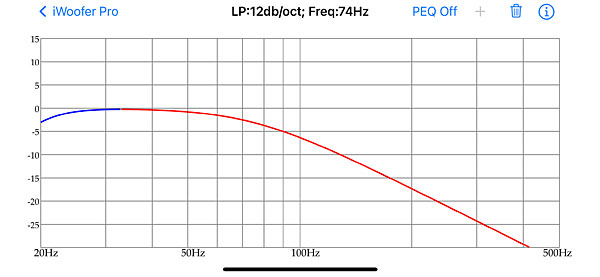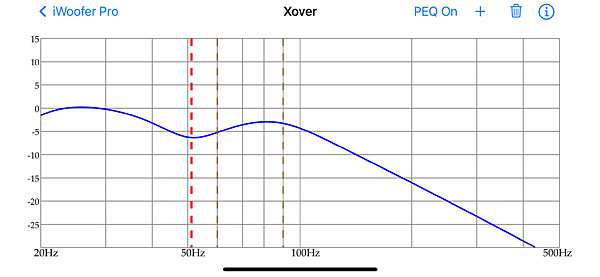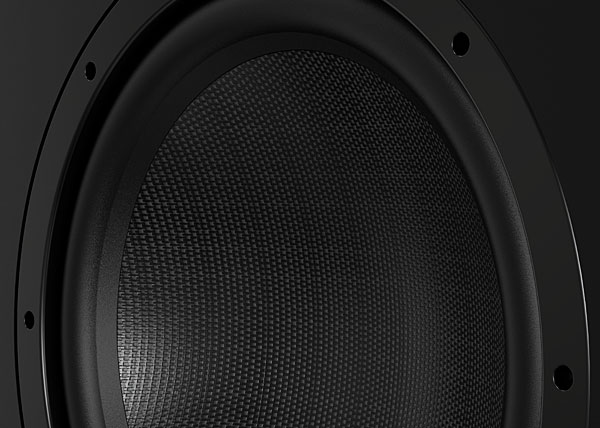OSD Black Trevoce 12 EQ DSP Subwoofer Review Page 2
Another iWoofer feature extensively detailed in the manual is the Room Correction/Auto EQ functions provided in the app's Pro version. However, an OSD Audio rep I spoke with said "if you are using your internal cell-phone mic [as you would when using an iOS/android app like iWoofer], you cannot get accurate results below 50Hz," citing that as a key limitation. So, rather than deal with inaccurate results, I instead used the free REW (Room EQ Wizard) software running on my Mac computer, along with a calibrated microphone from Dayton Audio, to measure the sub's output from the listening position in both rooms. This allowed me to properly set the EQ to compensate for measured room modes in both spaces, as well as extend the sub's response down to the 20Hz region. Using REW also helped me determine the best crossover settings for both setups (60Hz and 12dB/octave for the GoldenEar speakers, 80Hz and 24dB/octave for the Polk Audio rig).


Performance
Starting out in the music room, I first streamed Steven Wilson's "King Ghost" from his album The Future Bites (24-bit/96kHz FLAC, Qobuz). The swells of bass in this song were rendered in a clean and very dynamic manner. There was also a distinct fullness to the low end that added warmth to the overall sound and provided a solid foundation for the electronic drums, synths, and ethereal vocals to float upon. Comparing the sub's performance with EQ switched off, the bass came across notably muddier, and dynamics were muted as well.
The same qualities I noted in the Wilson track carried over when I next spun "Valley" from The Orb's 1995 album Orbus Terrarum on CD. This electronic track features truly deep, subsonic bass, and I was impressed with how much of it I was hearing with the Trevoce 12 in my setup. The cascading rise and fall of the synthesized bass line had a clean quality, while the occasional low slam of percussive elements was conveyed with impressive power and tactile impact. I was also able to push the volume to near-uncomfortable levels and not experience loss of clarity—the sub tracked the loudness increase in an easy, agile manner.
Moving on to something more traditional, I played "The Price of Love" (24/96 FLAC, Qobuz) an Everly Brothers cover from the new Alison Krauss/Robert Plant album Raise the Roof. This track has a dense production that could sound murky on a sloppily tuned system, but here it had a strong sense of continuity, with the bass and deep, sonorous percussion cleanly balanced against the vocals and acoustic stringed instruments. Raise the Roof is also available in an Atmos mix on Apple Music, and when I played "The Price of Love" and "King Ghost" in the home theater using an Apple TV 4K, the low end on both tracks sounded nuanced and clean, again providing a solid foundation for the more "spatial" and ethereal elements in the mix to lift off from.

Okay, movie time. Watching the antiques warehouse fight scene from John Wick 3 on 4K Blu-ray, the gunhshots, kicks, and punches were conveyed with a solid and very satisfying impact. Also, more subtle (or rather, less explicit) elements in the soundtrack like the thumping of footsteps on the ware- house's wooden floor were clearly fleshed out and added a dynamic quality to the presentation.
Given what I'd heard so far from the Trevoce 12, I wasn't surprised when I cued up the scene from Christopher Nolan's Tenet where a plane gets hijacked and smashed into a hangar (to create a diversion) and heard the massive impact I expect. Rumbling elements in the soundtrack were conveyed without bloat. Ludwig Göransson's droning, bass-heavy score was also rendered in a dynamic manner that created extreme tension—the composer's intent, no doubt.
Conclusion
While there are other 12-inch subwoofers offering DSP and app-based control in its price range, the Trevoce 12's neat looks, compact form, and powerful, yet nuanced performance make it a worthy competitor. The free iWoofer control app can initially cause some frustration, but once you learn how to walk the walk, it's mostly easy to use, and the extensive range of presets it allows will be of keen interest to bass tweakers. I honestly wasn't sure what to expect from the Trevoce 12, but the proof is in the listening, and I ended up very impressed with what I was hearing.




























































